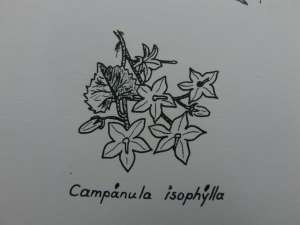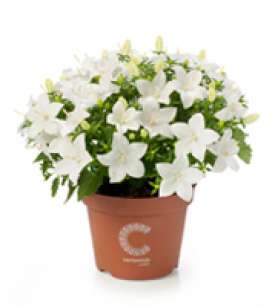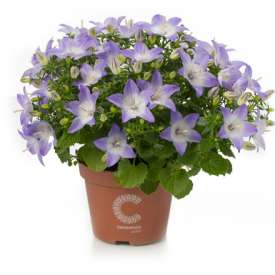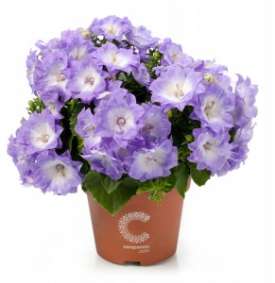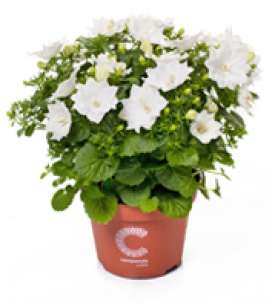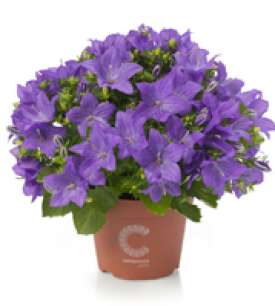Inhoud
isophylla
Campanula isophylla
L.
Moretti (1824)Section VI: Elatines Wohlf. (1895)1)
Synonym: Campanula floribunda Viv. (1824, serius)2)
Campanula lasiocarpa x Campanula isophylla = ? alpine-type hanging plant.
Campanula isophylla is a long-day plant (Heide, 1965) which is propagated by means of cuttings derived from vegetatively-growing stock plants. By giving the stock plants short days during the summer months, propagation can start in the fall and continue throughout the winter.
In order to obtain a high yield of cuttings, the stock plants must be illuminated and given a suitable temperature. An improved cutting production may be obtained by CO2 enrichment of the greenhouse atmosphere3).Names
Italian Bells, Star-of-Bethlehem, Falling-Stars, Bethlehem Bells, Bethlehemster of Ster van Bethlehem.
Habitus
Ha foglie tutte della medesima grandezza, cuoriformi-ovate, lungamente picciolate. Il fusto, flessuoso ed angoloso, e originato dirattamente da un rizoma legnoso ed e alto da 10 a 40cm.4)
Altezza: cm. 10-15. E una specie erbacea perenne, non rustica. E una pianta molto bella e di generosa fioritura, con piccoli fiori a forma di campanula bianchi o azzurri. Ha portamento quasi prostrato e strisciante.5)
Perenni. Piante alpine, alte 5-15cm., a fusti 1 (rr. 2-4)-flori. Pianta pubescente, a rz. legnosetto, a fusti cespugliosi, con rami patenti (1-2dm.)( :ref:adrianofiori01 ))
Campanula fragilis - Altezza: cm. 1-12. E abbastanza simile alla Campanula isophylla, ma piu piccola, piu aggraziata, con fusti e rami piu prostrati.6)
Glabrous or grayish-pubescent perennial, stems slender, trailing. Rosette-like plant forming many lateral shoots during the vegetative stage of growth.In its natural habitat the shoots start to elongate and produce a 20-40cm tall flowering plant in June-July 7).
The species has upright to decumbent or hanging, branched shoots bearing flowers solitary on bracted branchlets at the end of the stems 8).
Kleine, meist rasenbildende Arten mit traubigen, meist wenigblutigen Blutenstanden. 9)
Leaves
Ha foglie tutte della medesima grandezza, cuoriformi-ovate, lungamente picciolate. 10)
Fg. tutte della stessa grandezza (eccett. le Florali), cuoriformi-ovali e lungam. picciolate. Fg. acutam. ed un po'inegualm. dentate.( :ref:adrianofiori01 ))
Lower leaves long-petioled, broadly cordate-ovate, to 1 ½ in. long, deeply serrate, upper leaves often more lanceolate.
The leaf shape varies from shortly cordate in 'Alba' to cordate in the blue-flowered cultivar11).
Flowers
Fiorisce da giugno ad ottobre. La pianta ha aspetto cespuglioso, con rami patenti e fiori a calice con lobi acuminati. Le corolle, a forma di scodella, hanno lobi largamente ovali e colore azzurro-violaceo.12)
Fioritura: VI-VII. E una pianta molto bella e di generosa fioritura, con piccoli fiori a forma di campanula bianchi o azzurri.13)
Giu.-Ott. Fi. in pannocchia corimbosa. Calice a lobi lanceolato-acuminati, interi o con 1-2 denti. Corolla azzurro-violacea, fatta a scodella, a lobi largam, ovali.( :ref:adrianofiori01 ))
Flower measuring,between 15 - 25mm (5/8 to 1 inch.)14)
June - July, numerous flowers, erect, many in short, corymbose panicles, calyx without appendages, corolla violet-blue, grayish toward the center, to 1-1 ½ in. across, rotate-campanulate.
The wild growing species has pale blue flowers. Flowers usually have a five-lobed corolla, but occasionally 6-lobed flowers occur in the blue-flowered cultivar 'Bla'.
The diameter of fully openend flowers is about 30-40mm, and more than 900 flowers and flower buds have been counted on a single plant15).
It has been known since 1932 that flowering in Campanula isophylla is promoted by supplementary lighting in the winter (Roodenburg, J.W.M., Kunstlichtcultur II, Meded. LandbHogesch. Wageningen, 62(13), 1-37, 1932.16).
Fruit
Need seed. Species actually grown or used for breeding 17)
Kapsel nahe am Grunde aufspringend (Hangende Kapseln springen meist nahe am Grunde, aufrechte nahe den Kelchb. auf. Man kann daher im Allgemeinen die Art des Aufspringens aus der Stellung der verbluhten Bl. erschliessen, besonders wenn diese gestielt sind.) Sect. I Medium Tourn. (als Gatt.). B. Triloculares. Kapsel 3facherig (seltener bei ein- und derselben Art hier und da auch 5facherig) 18)
Varieties
* Campanula isophylla var. alba - Species actually grown or used for breeding 19)
* Campanula isophylla var. floro-pleno - Species actually grown or used for breeding 20)
Cultivars
- Campanula isophylla cv. 'Alba' - See also Campanula Isophylla cv. 'Atlanta White'
isophylla Alba :Orig 018705-0313-79 Locn 1A EU, rec: URCU: 1ab: 1, ayr: 79 21) A white-flowered form var. alba or maybe a selection from this is cultivated as 'Alba'22). The white flowering cultivar Campanula isophylla cv 'Alba' and a blue flowering cultivar called Campanula isophylla cv 'Bla', are mainly used. To some extent the blue flowering Campanula isophylla cv 'Mayii' is cultivated.
- Campanula isophylla Moretti cv. 'Alba' 1298-44. Fr.: Campanule, Ang.: Bellflower. ID/H.T. 16-6-45. Arr.: Campanula isophylla Par.: J. Rousseau, De: Félícité Leclerc, Ile aux Coudres, 16-11-44. Descr.: 1 plante. 1. Serre 1, 1 - 1/5-12-44; 2. couche fr. 5, 5 boutures - 20-10-45; 3. serre - 26-12-45; 4. couche fr. 5, 7 8-10-46; serre fr. 1, 2 (a ;étre rejetées), 10-3-47; 5. couche fr. 5, 1, 6-10-47, serre 1, 1 panier; 6. serre 1, 1 panier, 3-1-49, 7. serre 1, 1 panier - verso 25-1-50, 8. serre 1, 1 panier, 25-1-50, 9. serre 1, 1 panier, 4-12-51.23)
- Campanula Isophylla cv. 'Atlanta White' also known as Campanula Isophylla Alba.
A single, large-flowering Campanula with a white flower. Traditionally, the Campanula Isophylla family is the house plant among the Campanula. The Isophylla varieties are also well suited for balconies and patios. The natural flowering period outdoors is from May to September – a real spring and summer plant! Number: VBN 104648. Height: 20 – 25 cm, pot 11 cm.24)
- Campanula Isophylla cv. 'Balchiniana' - is like the type, but with silver variegated leaves. It is, I believe, the only variegated-leafed Campanula. It was raised from seed by Mr. Mitten, of Hurstpierpoint, from a cross made between the type and its white-flowered form, and this was the only plant that appeared. The stock passed into Messrs. Balchin's hands for distribution.25)
- Campanula Isophylla cv. 'Berlin Bicolor'
A single, large-flowering Campanula with a blue flower with white heart. Traditionally, the Campanula Isophylla family is the house plant among the Campanula. The Isophylla varieties are also well suited for balconies and patios. The natural flowering period outdoors is from May to September – a real spring and summer plant! Number: VBN 104649. Height: 20 – 25 cm.26)
- Campanula isophylla cv. Blue Kristal. Propagation is usually done by to cuttings from vegetatively growing stock plants. Recently, seeds of blue ('Blue Kristal') and a white-flowered ('White Kristal') cultivars of Campanula isophylla hybrids have been introduced.27).
- Campanula isophylla cv ‘Caerulea’ flowers blue.
- Campanula Isophylla cv. 'Dublin Bicolor'
New and with limited availability. A double-flowered large -flowered Campanula which is lavender blue in colour with a white heart. The Campanula Isophylla family has traditionally been the true houseplant amongst the Campanulas. The other Campanula varieties were originally more garden plants. The natural flowering period outdoors is between May and September. A real spring and summer plant! Number: VBN 112026. Height: 20 – 25 cm. Pot size: 11 cm.28)
* Campanula Isophylla cv. 'Dublin Blue'
A double, large-flowering Campanula with a blue flower. Traditionally, the Campanula Isophylla family is the house plant among the Campanula. The Isophylla varieties are also well suited for balconies and patios. The natural flowering period outdoors is from May to September – a real spring and summer plant! Number: VBN 102195. Height: 20 – 25 cm in 11 cm pot.29)
- Campanula Isophylla cv. 'Dublin White'
A double, large-flowering Campanula with a white flower. Traditionally, the Campanula Isophylla family is the house plant among the Campanula. The Isophylla varieties are also well suited for balconies and patios. The natural flowering period outdoors is from May to September – a real spring and summer plant! Number: VBN 102196. Height: 20 – 25 cm in 11 cm pot.30)
- Campanula isophylla cv. ‘Mayii’ grayish-pubescent, large-flowerd, blue.
Is supposed to be a derivative of the wild growing species. For commercial use the cultivar 'May' has been almost replaced by a Norwegian selection called 'Norsk' or 'Bla'31). All make excellent basket plants.
- Campanula isophylla Moretti cv. 'Mayi' 1337-44. De: Wm. Norsch & Son, Maplewood, Oregon, 18-12-44. Descr.: 2 plantes.32)
A very beautiful one brought to our notice two years ago: it appears to be quite hardy.33)
- Campanula isophylla cv. 'Napoli'
A single, large-flowering Campanula with a blue/purple flower. Traditionally, the Campanula Isophylla family is the house plant among the Campanula. The Isophylla varieties are also well suited for balconies and patios. The natural flowering period outdoors is from May to September – a real spring and summer plant! Number: VBN 16710. Height: 20 – 25 cm in 11 cm pot.34)
- Campanula isophylla cv. 'Norsk' or 'Bla' - flowers blue. This cultivar has darker blue flowers and better growth than 'Mayi'35).
- Campanula isophylla cv. White Kristal. Propagation is usually done by to cuttings from vegetatively growing stock plants. Recently, seeds of blue ('Blue Kristal') and a white-flowered ('White Kristal') cultivars of Campanula isophylla hybrids have been introduced 36).
Living
A highly decorative but tender prostrate species, said to be found on one rock only on a promontory on the west coast of Italy. 37)
ca. 300 years to find in the fields of Asia and Europe38).
Originally a wild growing perennial in the Italian Alps. Has become an important pot plant in the Scandinavian countries. All make excellent basket plants.
Campanula isophylla Moretti is a long day plant (Heide, 1965), and by means of long day treatment flowering pot plants are obtained in early spring (March-April). By giving the stock plants short days during the summer months, propagation can start in the fall and continue throughout the winter.
It is important to use cuttings from vegetatively growing stock plants in order to obtain a satisfactory rooting39).
Vuole terreno poroso, calcareo, non troppo ricco.40)
Jsou mezi nimi druhy dosahující horní hranice vyskytu rostlin, jako napr. C. tridentata z Kavkazu ci C. cenisia z Alp, ale i druhy nízinné jako C. isophylla, osidlující prímorské skály.41)
Origin
E uno dei piu importanti endemismi della Liguria nascendo solamente sulle rocce di Capo Noli dove. E certamente l'endemismo piu noto del panorama vegetale ligure limitato alla zona attorno al Capo Noli, Varigotti e alla Caprazzoppa. Assieme alla Campanula sabatia, la “Campanula di Liguria” - constituisce uno dei preziosi reperti naturalistici da custodire con gelosa cura. 42)
Originaria dell'Italia e precisamente della Liguria occidentale; si incontra molto raramente in cultura. 43)
Italy, North Italian Alps, Riviera.
Rupi calcari: Lig. occ. al Capo di Noli, Caprazoppa, Verezzi e Varigotti; 2. (Endem.)( :ref:adrianofiori01 ))
Breeding
The whole of the isophylla group are easily struck from the young growing tops. Any light soil seems to suit these isophylla hybrids, but they must not be considered any hardier than the type.44)
The production of cuttings will be influenced by temperature, light intensity and CO2 supply. Cuttings are about 4cm and have 5-6 visible leaves after the lowest 2-3 leaves are been removed. After 3 weeks the rooted cuttings can be planted in pots.
Increasing light intensity and CO2, supply strongly promoted cutting production and increased both fresh and dry weight of the cuttings. These factors also markedly influenced root formation and root growth of the cuttings. Stock plant conditions also strongly influenced the growth and lateral shoot formation of the rooted cuttings. It is concluded that cuttings from stock plants grown under favourable light (10 Klx) and CO2 conditions (900 v.p.m.) contain factors beneficial for toot formation, growth and shoot formation. The results are discussed in relation to the carbohydrate content of the cuttings45).
The process of root formation and factors affecting the rooting of cuttings are of great horticultural importance. A number of factors affect the rooting procedure. Auxin is the most active hormone (Went, 1934; Van Overbeek and Gregory, 1945), and the effect of auxin is dependent on the light conditions (Olieman-van der Meer et al., 1971; Nanda et al., 1968). These authors als showed that rooting was stimulated by sucrose. Van Overbeek et al. (1946) demonstrated that sucrose and NH4 in the presence of auxin could fulfill the same function as the leaves in root formation in cuttings of Hibiscus. A high concentration of carbohydrate stimulated the rooting46).
Use
I find it hardy only in vertical crevices in a limestone wall like rockery; autumn rains seem to destroy all its vigour. The late Mr. Atkins used to grow it well on the open rockery in limestone soil at his elevated garden in the Cotswold Hills twenty years ago. The white form has now got extensively into cultivation as a hanging or basket plant, and is absolutely the best plant ever used for this purpose.47) Le piantine o i semi di molte altre Campanule nostrane entrate in commercio: la famosa Campanula isophylla consigliata per vasi e terrine sospese. 48)
Meglio coltivata come pianta da vaso, piuttosto che in giardino, talvolta usata anche come pianta da appartamento. All'aperto e adatta per il giardino roccioso o per essere coltivata nei muri o in cestini, in posizioni calde e soleggiate.49)
Come si coltiva. La Campanula non e generalmente un fiore difficile da coltivare. Essendo originaria delle zone temperate dell'emisfero boreale, dove cresce su terreni freschi o umidi di regioni in prevalenza montane, richiede, oltre a un'esposizione luminosa e non troppo soleggiata, le stesse condizioni ambientali: il terreno, fatta eccezione per qualche specie, deve contenere una certa percentuale di calcio. Questo non significa che le Campanula non si possano coltivare magnificamente anche su un terrazzo assolatissimo. Per esperienza personale posso assicurare che la Campanula pyramidalis, la Campanula isophylla, la Campanula glomerata, la Campanula garganica, la Campanula carpatica, la Campanula fragilis e la Campanula persicaefolia, per limitarsi a poche, prosperano ottimamente sul terrazzo sotto un sole cocente, purche generosamente annaffiate. La Campanula carpatica e la Campanula garganica possono essere coltivate bene anche in vasi di cm. 16-18 di diametro, mentre la Campanula pyramidalis vuole uno spazio maggiore (cm 30) e la Campanula glomerata una misura intermedia. 50)
Dvouleté a monokarpické druhy s sedavé chlupatou prízemní rúzicí listú pocházející z jizní Evropy a Malé Asie, jako napr. CC. formanekiana, sartori, tomentosa a celou radu dalsich, které nejsou dosud v kulturé, péstujeme na slunnych, velmi propustnych stanovistích, protze zvlásté v zimé trpí prílisnou vlhcestí. Druhú, které nesnáseji mrazy vsak neni mnoho. Z. popisovanych druhú je to napr. C. isophylla a cástecné C. cashmiriana.51)

